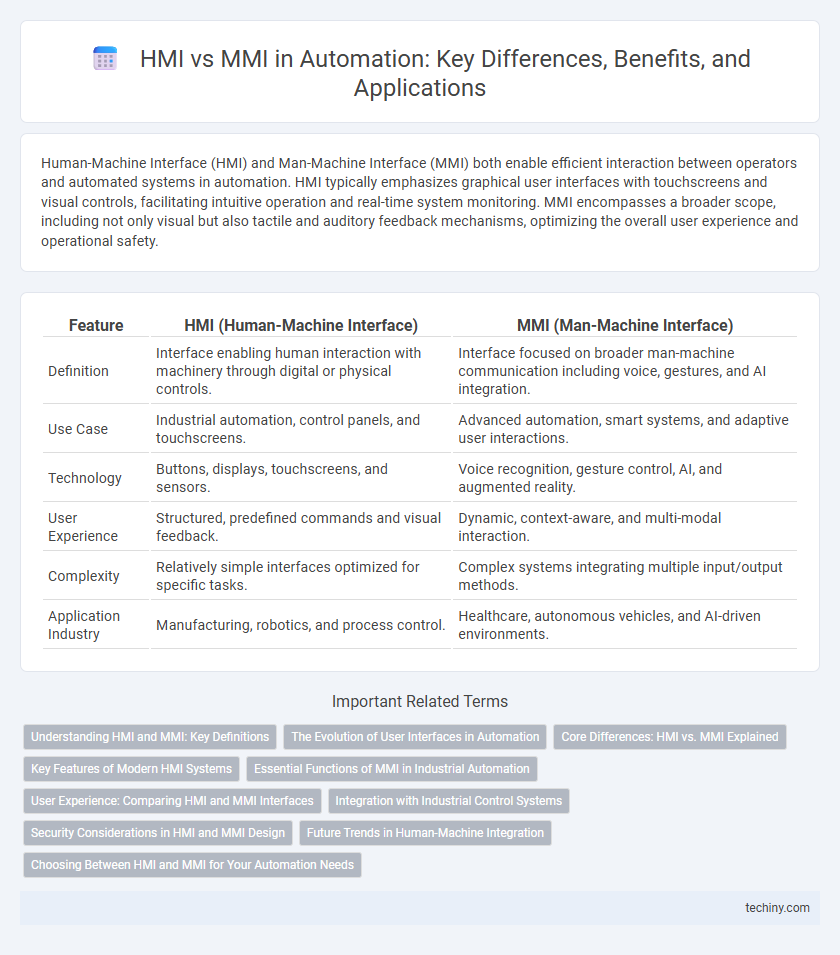Human-Machine Interface (HMI) and Man-Machine Interface (MMI) both enable efficient interaction between operators and automated systems in automation. HMI typically emphasizes graphical user interfaces with touchscreens and visual controls, facilitating intuitive operation and real-time system monitoring. MMI encompasses a broader scope, including not only visual but also tactile and auditory feedback mechanisms, optimizing the overall user experience and operational safety.
Table of Comparison
| Feature | HMI (Human-Machine Interface) | MMI (Man-Machine Interface) |
|---|---|---|
| Definition | Interface enabling human interaction with machinery through digital or physical controls. | Interface focused on broader man-machine communication including voice, gestures, and AI integration. |
| Use Case | Industrial automation, control panels, and touchscreens. | Advanced automation, smart systems, and adaptive user interactions. |
| Technology | Buttons, displays, touchscreens, and sensors. | Voice recognition, gesture control, AI, and augmented reality. |
| User Experience | Structured, predefined commands and visual feedback. | Dynamic, context-aware, and multi-modal interaction. |
| Complexity | Relatively simple interfaces optimized for specific tasks. | Complex systems integrating multiple input/output methods. |
| Application Industry | Manufacturing, robotics, and process control. | Healthcare, autonomous vehicles, and AI-driven environments. |
Understanding HMI and MMI: Key Definitions
Human-Machine Interface (HMI) refers to the user interface that connects operators to machines, enabling monitoring and control through graphical displays and input devices. Man-Machine Interface (MMI) broadly encompasses all communication methods between humans and machines, including HMI but also physical controls like buttons and switches. Understanding the distinction helps optimize automation systems by selecting appropriate interfaces tailored to specific operational requirements and user interactions.
The Evolution of User Interfaces in Automation
Human-Machine Interface (HMI) has evolved into Man-Machine Interface (MMI) to reflect more intuitive and interactive automation systems, enhancing operator control and feedback mechanisms. Advanced MMIs incorporate touchscreens, voice commands, and augmented reality to improve real-time decision-making and reduce human error in industrial environments. This evolution drives efficiency and safety by seamlessly integrating complex data visualization with adaptive user experiences.
Core Differences: HMI vs. MMI Explained
HMI (Human-Machine Interface) primarily facilitates interaction between operators and machines through graphical displays, focusing on control and monitoring in industrial automation. MMI (Man-Machine Interface) encompasses a broader scope, including all forms of communication between humans and machines, integrating sensory, feedback, and control mechanisms beyond visual inputs. Core differences lie in HMI's specialized role in industrial contexts versus MMI's comprehensive approach to human-machine interaction across various technologies and applications.
Key Features of Modern HMI Systems
Modern HMI systems feature intuitive graphical user interfaces that enable real-time monitoring and control of complex automation processes with high precision. They support multi-touch capabilities, customizable dashboards, and advanced data visualization, enhancing operator efficiency and reducing response time. Integration with IoT devices and seamless connectivity to SCADA systems are essential for predictive maintenance and data-driven decision-making in industrial environments.
Essential Functions of MMI in Industrial Automation
Human-Machine Interface (HMI) primarily enables operators to monitor and control industrial processes, while Man-Machine Interface (MMI) incorporates advanced functionalities such as real-time data visualization, adaptive feedback systems, and predictive maintenance alerts. Essential functions of MMI in industrial automation include seamless integration with SCADA systems, intuitive multi-touch interfaces for rapid decision-making, and enhanced safety protocols through automated fault detection. These features optimize operational efficiency, reduce downtime, and improve overall system reliability in complex manufacturing environments.
User Experience: Comparing HMI and MMI Interfaces
HMI (Human-Machine Interface) and MMI (Man-Machine Interface) both facilitate user interaction with automated systems, yet MMI emphasizes ergonomic and intuitive design that enhances user experience by reducing cognitive load. HMI often targets technical operators with complex control layouts, whereas MMI aims to simplify interactions through multimodal interfaces incorporating touch, voice, and gesture controls. Advanced MMI interfaces improve accessibility and usability in automation, leading to increased efficiency and reduced user errors compared to traditional HMI systems.
Integration with Industrial Control Systems
HMI (Human-Machine Interface) and MMI (Man-Machine Interface) both serve as essential bridges between operators and industrial machinery, but HMI offers enhanced integration capabilities with industrial control systems like SCADA and PLCs. HMI platforms support real-time data visualization, bidirectional control commands, and seamless interoperability with IoT sensors, enabling advanced process monitoring and automation. Improved integration with industrial protocols such as OPC UA and Modbus positions HMI as the preferred choice for efficient, scalable system control in modern automation environments.
Security Considerations in HMI and MMI Design
Security considerations in HMI (Human-Machine Interface) and MMI (Man-Machine Interface) design are critical for protecting automated systems from cyber threats. HMI security focuses on access control, authentication, and encryption to prevent unauthorized manipulation of industrial processes, while MMI design incorporates user behavior analysis and secure interaction protocols to mitigate risks of social engineering attacks. Both interfaces require continuous security updates and integration of intrusion detection systems to ensure resilience against evolving cyber vulnerabilities.
Future Trends in Human-Machine Integration
Human-Machine Integration is evolving with advancements in HMI (Human-Machine Interface) and MMI (Man-Machine Interface) technologies, focusing on seamless interaction through AI-driven voice commands, augmented reality displays, and adaptive touchscreens. Future trends emphasize immersive experiences enabled by neural interfaces and predictive analytics that anticipate user intentions, significantly enhancing automation responsiveness. Integration of IoT connectivity and edge computing further accelerates real-time decision-making, transforming industrial and consumer automation landscapes.
Choosing Between HMI and MMI for Your Automation Needs
When selecting between HMI (Human-Machine Interface) and MMI (Man-Machine Interface) for automation, prioritize the complexity of user inputs and system outputs to optimize operational efficiency. HMI typically emphasizes digital and graphical interfaces suitable for complex industrial control systems, while MMI may incorporate broader interaction modes, including tactile and voice inputs, beneficial for varied automation setups. Assessing the specific automation environment, user roles, and integration capabilities ensures the chosen interface aligns with performance requirements and enhances user experience.
HMI vs MMI Infographic

 techiny.com
techiny.com